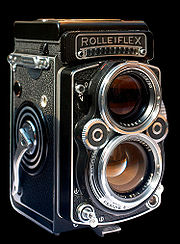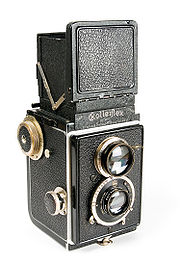
Rolleiflex
Encyclopedia

Camera
A camera is a device that records and stores images. These images may be still photographs or moving images such as videos or movies. The term camera comes from the camera obscura , an early mechanism for projecting images...
s originally made by the German company Franke & Heidecke, and later Rollei-Werk. The "Rolleiflex" name is most commonly used to refer to Rollei's premier line of medium format twin lens reflex (TLR) cameras. (A companion line intended for amateur photographers, Rolleicord
Rolleicord
The Rolleicord was a popular medium-format twin lens reflex camera made by Franke & Heidecke between 1933 and 1976. It was a simpler, less expensive version of the high-end Rolleiflex TLR, aimed at amateur photographers who wanted a high-quality camera but could not afford the expensive Rolleiflex...
, existed for several decades.) However, a variety of TLRs and SLRs in medium format, and zone focus, and SLR 35 mm, as well as digital
Digital photography
Digital photography is a form of photography that uses an array of light sensitive sensors to capture the image focused by the lens, as opposed to an exposure on light sensitive film...
formats have also been produced under the Rolleiflex label. The 120 roll film Rolleiflex series is marketed primarily to professional photographers. Rolleiflex cameras have used film formats 117 (Original Rolleiflex), 120 (Standard, Automat, Letter Models, Rollei-Majic, and T model), and 127 (Baby Rolleiflex).
The Rolleiflex TLR film cameras were notable for their exceptional build quality, compact size, modest weight, superior optics, durable, simple, reliable mechanics and bright viewfinders. They were popular and widely imitated. The high-quality 7.5cm focal length lenses, manufactured by Zeiss and Schneider
Schneider Kreuznach
Schneider Kreuznach is the abbreviated name of the company Jos. Schneider Optische Werke GmbH, which is sometimes also simply referred to as Schneider. They are a manufacturer of industrial and photographic optics....
, allowed for a smaller, lighter, more compact camera than their imitators, further differentiating the Rolleiflex TLR from many of its competitors, who were forced by inferior optics to use 8.0cm or 8.5cm focal length lenses. Unique to the Rolleiflex Automat and letter model cameras, the mechanical wind mechanism was robust and clever, making film loading semi-automatic and quick. This mechanism started the exposure counter automatically, auto-spaced the 12 or 24 exposures, and tensioned the shutter; all with less than one full turn of the film advance crank. This makes the Rolleiflex Automat/Letter model cameras very sought-after for shooting fast paced action, such as street photography. A wide range of accessories made this camera a system: panorama head, sun shade, parallax-corrected close-ups lenses, color correction, contrast enhancing, and special effect filters, all mounted with a quick release bayonet, as well as a quick-change tripod attachment. Some amateur and fine-art photographers still shoot Rolleiflex TLR film cameras with color transparency, color negative, or black-and-white film. The later f2.8 and f3.5 letter models (Planar or Xenotar lens) are highly sought after in the used market, and command the greatest price. Rolleiflex TLRs are no longer manufactured. Historically there were five focal length cameras available include 5.5cm Rollei-Wide, 6.0cm Baby Rollei, 7.5cm (f:3.5), 8.0cm (f2.8), and 13.5cm (f:4 Zeiss Sonnar) Tele-Rolleiflex. Although all Rolleflex cameras can be fine user cameras, there is also, an active market for many Rolleiflex models as collectables, and this adds (greatly in some models) to the end price paid, particularly in Japan
Japan
Japan is an island nation in East Asia. Located in the Pacific Ocean, it lies to the east of the Sea of Japan, China, North Korea, South Korea and Russia, stretching from the Sea of Okhotsk in the north to the East China Sea and Taiwan in the south...
.
Original Rolleiflex

Rolleiflex Automat
- Introduced an automatic film counter; this counter senses the thickness of the film backing to accurately begin counting frames, obviating the need for the ruby window that forced the photographer to read the frame number off the back of the film itself.
- This model won the Grand Prix award at the Paris World's FairWorld's FairWorld's fair, World fair, Universal Exposition, and World Expo are various large public exhibitions held in different parts of the world. The first Expo was held in The Crystal Palace in Hyde Park, London, United Kingdom, in 1851, under the title "Great Exhibition of the Works of Industry of All...
in 1937. - The first Rolleiflex to offer a Schneider KreuznachSchneider KreuznachSchneider Kreuznach is the abbreviated name of the company Jos. Schneider Optische Werke GmbH, which is sometimes also simply referred to as Schneider. They are a manufacturer of industrial and photographic optics....
Xenar taking lens as an option, in addition to the Carl Zeiss Tessar.
Rolleiflex 2.8A
Incorporated the first f2.8 taking lens (either an 80 mm Carl Zeiss Tessar or Opton Tessar) into the Rolleiflex line. It also added an X flash synch contact.Tele Rolleiflex
This camera used a 135 mm/f4.0 Carl Zeiss Sonnar taking lens. The introduction to a 1990 sale catalogue by Sotheby's auction house in London estimated that approximately 1200 cameras existed at that date.The new Tele Rolleiflex uses 135mm/f4 Schneider Tele-Xenar taking lens
Wide Rolleiflex
This camera had a 55 mm/f4.0 Carl Zeiss Distagon taking lens. The introduction to a 1990 sale catalogue by Sotheby's auction house in London estimated that fewer than 700 such cameras existed at that date. Only 3600 models have been originally produced.The new Wide Rolleiflex uses a 50mm/f4 Schneider Super-Angulon taking lens.
Rolleiflex Digital Reproductions
There are two current models of miniature Rolleiflex digital cameras. These are not true Rolleiflex cameras but are miniature reproductions of the Rolleiflex TLR design produced under license by the German camera manufacturer MinoxMinox
The Minox is a subminiature camera conceived in 1922 and invented in 1936 by German-Latvian Walter Zapp, which Latvian factory VEF manufactured from 1937 to 1943. After World War II, the camera was redesigned and production resumed in Germany in 1948. Originally envisioned as a luxury item, it...
. The cameras are manufactured by the Japanese company Sharan.
The original model, now discontinued, was the Rolleiflex MiniDigi, a miniature reproduction of the TLR Rolleiflex. In many details the camera retained the details of the original, including a waist level view finder and a hand crank to prepare the camera for the next shot. As the name implies, the camera was a digital reproduction, with the "viewing" lens being a dummy. The camera had a 2 megapixel CMOS sensor in the square format of the traditional TLR. The lens was a 9 mm f/2.8 with 5 elements, focussing down to 10 cm. The shutter speeds were automatically controlled between 1/15 to 1/400 second, exposure time was automatic. The camera was operated by a single CR2 battery. The storage media was either SD or MMC cards.
This was superseded by the MINOX DCC (Digital Classic Camera) Rolleiflex AF 5.0. The name change brings the current model more firmly in line with the rest of Minox's Classic Camera miniature reproduction range. It is visually identical to the original model, but available in both black and red leather finishes. The CMOS sensor has been upgraded to 3 megapixels, with 5.0 megapixels available by interpolation
Interpolation
In the mathematical field of numerical analysis, interpolation is a method of constructing new data points within the range of a discrete set of known data points....
. The taking lens is a 4.9 mm f/2.8; the camera has digital autofocus. The electronic shutter has also been upgraded to a maximum speed of 1/2500 of a second. The camera operates on a single CR2 battery and uses miniSD memory cards.
Tessar Models
Rolleiflex Cameras—7.5 cm (f: 2.8, 3.5, 3.8)- Original Rolleiflex: 1929–32
- Standard Rolleiflex: 1932–38
- New Standard Rolleiflex: 1938–41
- Rolleiflex Automat: 1937–39
- Rolleiflex Automat: 1939–49 (double bayonet)
- Rolleiflex Automat X: 1949–51
- Rolleiflex Automat MX: 1951–54
- Rolleiflex Automat MX-EVS: 1954–56
- Rolleiflex 4×4: 1931–38 Baby Rolleiflex (1930s) (6 cm f:3.5 or 2.8 Tessar lens)
- Rolleiflex 4×4: 1938–41 Sports Baby Rolleiflex (6 cm f:2.8 Tessar Only)
- Rolleiflex 2.8A: 1950–51
- Rolleiflex T: 1958–75 (no Automat film transport and with f:3.5 Tessar lens only. Grey or Black)
Pre-War Baby Rolleiflex
- Rolleiflex 4×4: 1931–38 Baby Rolleiflex (1930s) (6 cm f:3.5 or 2.8 Tessar lens) Two models, with rim set shutter and f. Deckel made diaphragm control, or with Rollei made levers on the shutter and a small shutter speed, f-number indicator window above the viewing lens. So in the first model of Pre-War Baby Rolleiflex there are actually four different cameras.
- Rolleiflex 4×4: 1938–41 Sports Baby Rolleiflex (6 cm f:2.8 Tessar Only) New fast focus with larger knob, front cover like a Rolleicord II, with early cameras having only one bayonet, and later cameras with two.
Non-Tessar models (Letter Models)
Planar or Xenotar lenses. f:2.8 cameras have 8 cm focal length, 3.5 ones 7.5 cm- Rolleiflex 2.8B: 1952–53, 8 cm Biometar lens (Rare)
- Rolleiflex 2.8C: 1953–55
- Rolleiflex 2.8D: 1955–56
- Rolleiflex 2.8E: 1956–59 (introduction of the f:3.5 Planar and Xenotar models)
- Rolleiflex 2.8E2: 1959–60
- Rolleiflex 2.8E3: 1962–65
- Rolleiflex 3.5E1: 1956–59 (optional uncoupled light meter)
- Rolleiflex 3.5E2: 1959–62
- Rolleiflex 3.5E3: 1962–65
Post War Baby Rolleiflex
- Rolleiflex 4×4: 1957–63 (Schneider, 6 cm f:3.5 Xenar lens, on all post war Rolleiflex 4×4 cameras)
- Rolleiflex 4×4 Black: 1963–69 (rare) By serial numbers 9,120 were made.
Couple exposure meter, removable focus hood
The F model introduced coupled exposure metering and removable focus hood on all subsequent models- Rolleiflex 2.8F: 1960–81 (various models)
- Rolleiflex 2.8F Aurum: 1983
- Rolleiflex 2.8F Platinum: 1987
- Rolleiflex 2.8GX: 1989 (from this model onward the Automat film transport was replaced with transport similar to the "T" model)
- Rolleiflex 2.8FX
Speciality cameras
Rollei responded with two models to the introduction of the Mamiya line of interchangeable lenses TLR cameras, the Tele Rolleiflex with 135 mm lenses, and the Rollei Wide with 55 mm.- Tele Rolleiflex: 1959–75 (Zeiss Sonnar)
- Rolleiflex Wide: 1961–67 (Zeiss Distagon)
- Wide Rolleiflex 4.0 FW (Schneider Angulon)
- Tele Rolleiflex 4.0 FT
- Rolleiflex 2.8F Mini
Miniatures
Reproductions by MinoxMinox
The Minox is a subminiature camera conceived in 1922 and invented in 1936 by German-Latvian Walter Zapp, which Latvian factory VEF manufactured from 1937 to 1943. After World War II, the camera was redesigned and production resumed in Germany in 1948. Originally envisioned as a luxury item, it...
- Rolleiflex MiniDigi
- DCC Rolleiflex AF 5.0
|}
Medium format SLRs
35 mm SLRs
|

